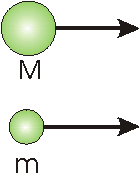Gravitational and Inertial Mass
|
Consider two bodies that have electric charge Q and
q. We know that because they carry electric charge, they exert forces on
each other. We call the force electrostatic. |
 |
|
Now we consider two bodies that have masses M and m.
Because they both have mass, in the Newtonian description we say that they
exert forces on each other. We call the force gravitation. |
 |
|
Now we consider two bodies with masses M and m that
are both moving to the right at the same speed relative to us. They both have
inertia. Since they are travelling at the same speed, the body with the
larger mass will have a larger inertia. |
 |
Above we have used the word mass in two different ways.
- We refer to the property of objects that causes them to interact
gravitationally with other objects with this property. The magnitude of
the gravitational interaction is proportional to the amount of gravitational
mass the objects have.
- We refer to the property of objects that gives them inertia.
The inertia of an object is the amount of its inertial mass times the
speed it is moving relative to use. Thus a very massive ship moving at a small
speed has considerable inertia, as does a light object moving at a high
speed.
Note that although we use the word "mass" in both cases, there is
no immediate and obvious reason why this inertial mass and gravitational mass
should be related to each other.
We can compare the gravitational mass of two objects by weighing them, i.e.
measuring their gravitational interaction with the Earth. We can also compare
the inertial mass of same two objects by measuring their effects in collisions
with other objects. These experiments have been done to great accuracy and precision,
and the comparisons always come out the same. Thus we conclude that the gravitational
and inertial mass are experimentally found to be the same for all objects.
This is different from comparing, say, the inertial mass of two objects with
their electric charges. There is no relation between the two, and we can have
an object with a large inertial mass but no electric charge and another object
with the same inertial mass and a non-zero electric charge.
One of the first reported experiments comparing inertial and gravitational
mass was performed by Newton. In 1888, two hundred years after Newton, the Hungarian
Eotvos did the first of a series a very sensitive measurements. Today these
experiments are still being repeated with ever-increasing precision and accuracy.
An experiment by Baessler et al. in 1999 had a sensitivity of one part in 1013.
This document is a fragment of a larger one on Einstein's General
Theory of Relativity. General Relativity is not part of the PHY138 curriculum.
The full document, however, is available at http://www.upscale.utoronto.ca/PVB/Harrison/GenRel/GenRel.html.


